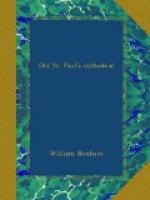Richard, Duke of York, swore fealty in most express terms to Henry VI. at St. Paul’s in March, 1452. He had been suspected of aiming at the crown. But the government grew so unpopular, partly through the disasters in France, partly through the King’s incapacity, that York levied an army and demanded “reformation of the Government.” And on May 23rd, 1455, was fought the battle of St. Albans, the first of twelve pitched battles, the first blood spilt in a fierce contest which lasted for thirty years, and almost destroyed the ancient nobility of England. York himself was killed at Wakefield, December 23rd, 1460. On the following 3rd of March his son was proclaimed King Edward IV. in London, and on the 29th (Palm Sunday) he defeated Henry’s Queen Margaret at Towton, the bloodiest battle ever fought on English ground. A complicated struggle followed, during which there was much changing of sides. Once King Henry, who had been imprisoned in the Tower, was brought out by the Earl of Warwick, who had changed sides, and conducted to St. Paul’s in state. But the Londoners showed that they had no sympathy; they were on the Yorkist side in the interest of strong government. Hall the chronicler makes an amusing remark on Warwick’s parading of King Henry in the streets. “It no more moved the Londoners,” he says, “than the fire painted on the wall warmed the old woman.” That is worthy of Sam Weller. In May, 1470, Henry died in the Tower, and his corpse was exhibited in St. Paul’s. It was alleged that as it lay there blood flowed from the nose as Richard Crookback entered, witnessing that he was the murderer. Richard afterwards came again to offer his devotions after the death of his brother, Edward IV., and all the while he was planning the murder of his young nephews.
Arthur, Prince of Wales, son of Henry VII., married Catharine of Aragon in St. Paul’s, November 14th, 1501. He died five months later, at the age of 15. The chroniclers are profuse in their descriptions of the decorations of the cathedral and city on that occasion. The body of Henry VII. lay in state at St. Paul’s before it was buried in Westminster Abbey.
This brings us to a new epoch altogether in our history. The stirring events now to be noted do not so much concern the material fabric of the cathedral as in the past, but they were of the most momentous interest, and St. Paul’s took more part in them than did any other cathedral.
[Footnote 1:
“This humble tomb our citizens placed
here
Unequal to thy merits, father dear;
For London’s people know how wisely
thou
Didst guide their fate, and gladly feel
it now.
Under thy guidance freedom was restored,
And noble gifts through thee on us were
poured.
Riches and earthly honours cease to be,
But thy good deeds abide in memory.”]
[Footnote 2: See Mediaeval London, p. 62.]
[Footnote 3: Page 25.]
[Footnote 4: There was a special order in the first year of Edward VI. that instead of this censing a sermon should be preached.]




